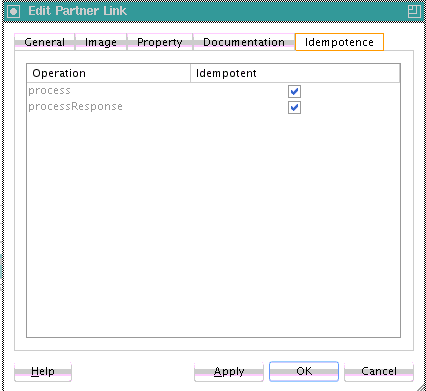What You May Need to Know About the idempotent Property and Fault Handling
If the idempotent deployment descriptor property is set to false in the composite.xml file and the invocation of a partner link fails, recovery does not start from the invoke activity. Relying on the idempotent property for retrying the invoke activity is not recommended. Instead, recovery is attempted by fault handling you have designed into the BPEL process (such as with a catchAll activity). As a best practice, Oracle recommends that you instead use a fault policy to retry the invoke activity.
Table 12-8 describes the behavior when the idempotent property is set to false and partner link invocation either succeeds or fails.
Table 12-8 Recovery Behavior When the idempotent Property Is Set to False
| If Partner Link Invocation Is... | Then... |
|---|---|
|
Successful |
The invoke activity is dehydrated immediately after execution and recorded in the dehydration store. |
|
Unsuccessful, and your BPEL process includes fault handling, such as a catchAll activity |
Recovery is started from the catchAll activity and not from the invoke activity. |
|
Unsuccessful, and your BPEL process includes a fault policy |
The fault policy is used to attempt recovery of the invoke activity. This is the recommended approach. |
For example, assume your BPEL process includes the following design:
-
An invoke activity invokes a partner link (for this example, named
myPartnerLink). -
The
idempotentdeployment descriptor property is set tofalsein thecomposite.xmlfile.<property name="bpel.partnerLink.myPartnerLink.idempotent">false</property>
This setting causes the BPEL process to dehydrate immediately after execution of this activity and be recorded in the dehydration store.
You can also set this property to
falsein the Edit Partner Link dialog. Figure 12-29 provides details.Figure 12-29 Idempotence Tab of Edit Partner Link Dialog

Description of "Figure 12-29 Idempotence Tab of Edit Partner Link Dialog"For more information, see Managing Idempotence at the Partner Link Operation Level.
-
A catchAll activity error handler in a scope activity catches faults and throws a rollback fault.
If the invocation by the invoke activity to the partner link fails, recovery starts from the catchAll activity error handler, and not from the invoke activity. The recovery from the catchAll activity can be observed in the flow activity for the BPEL process in Oracle Enterprise Manager Fusion Middleware Control.
This is by design. The idempotent property setting is checked after execution of the invoke activity. If the execution failed and an exception is raised, the idempotent property setting is never reached. The BPEL process service engine saves the instance right after opening the catchAll activity. The instance must be saved because the idempotent property is set to false. This is why recovery resumes in the catchAll activity.
Oracle recommends that you instead recover the failed invoke activity with a fault policy. For more information about creating fault polices, see Handling Faults with the Fault Management Framework.
For more information about the idempotent property, see Introduction to Deployment Descriptor Properties.